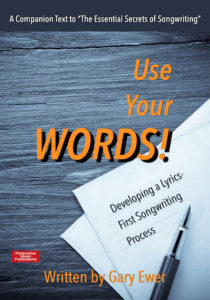How do you create a melody that works well in verse-only songs? Are they structured differently from verse melodies that lead to choruses?
The short answer to the second question is ‘yes’ — at least most of the time. Whether you look at classic rock examples of verse-chorus tunes (“The Night They Drove Old Dixie Down” – Robbie Robertson ) or something newer (“Look What You Made me Do” — Taylor Swift, Jack Antonoff, Richard Fairbrass, Fred Fairbrass, Rob Manzoli), it’s common for a verse to move upward to meet the chorus.
 The FREE DEAL continues… Get “Use Your Words!” free with your purchase of “The Essential Secrets of Songwriting 10-eBook Bundle”, and learn how to develop a lyrics-first songwriting process.
The FREE DEAL continues… Get “Use Your Words!” free with your purchase of “The Essential Secrets of Songwriting 10-eBook Bundle”, and learn how to develop a lyrics-first songwriting process.
And even if it’s not moving upward at its end, it’s common for the verse to end in a range that allows it to connect smoothly to the chorus.
But songs that are verse-only are, more often than not, an inverted-U, or perhaps inverted-V shape, where the middle (actually, usually shortly after the middle) of the verse contains the highest notes.
A common structure is to have a 4-phrase melody — like Amanda McBroom’s “The Rose” — where the 3rd phrase is the highest one.
A great recent example of a verse structure that doesn’t have a chorus to follow it is Ben Fold’s “So There”, from his 2015 album of the same name. It’s got an interesting modification, which is that the verse is comprised of 5 phrases, where the 3rd and 4th phrases are the high-pitched ones, and then ends with a lower phrase like the beginning:

Though it may look random, the inverted-U or V happens through the 3rd and 4th phrases, as in this simplified illustration:

This song uses a lengthy instrumental section in the middle, acting as a kind of bridge. So the verse melody operates as a stand-alone structure that doesn’t particularly need a chorus to explain its existence.
Why do many songwriters opt for this inverted-V kind of shape for songs that don’t use a chorus? Mainly because without a chorus, you still have the need for some kind of climactic moment. That climactic moment is naturally fulfilled by including a chorus. So without the chorus, you need some kind of shape that achieves the same thing that a chorus usually achieves: giving the song its highest notes.
Those highest notes don’t have to be overly high, mind you. Ben Folds moves his 3rd phrase up approximately one octave, but for most songs, as long as there’s a note in the 3rd phrase that extends beyond whatever the first 2 phrases offered, you’ve achieved what a climactic high point should be doing.
If you find that your verse-only songs (or any song that doesn’t use a chorus) sound a bit dull or uninteresting, it’s in the middle of the verse melody that you want to be focusing on:
- Is the 3rd phrase higher than the first 2 phrases? Find a way to get a higher note — even just one — into your 3rd phrase.
- Are the first 2 phrases simply too high? See if you can restructure the start of your verse so that it begins lower.
- Does the end of the melody sound relaxed? You’ll achieve this by ending on a tonic chord.
This inverted shape for a verse-without-chorus design is very common, but you can also use it for songs that do in fact use a chorus melody as well.
 Written by Gary Ewer. Follow Gary on Twitter.
Written by Gary Ewer. Follow Gary on Twitter.
 Get “The Essential Secrets of Songwriting” eBooks. They’ll help you polish your technique, and make you the best songwriter you can be. Comes with a Study Guide, tons of chord progressions, and information covering every aspect of how to write good music.
Get “The Essential Secrets of Songwriting” eBooks. They’ll help you polish your technique, and make you the best songwriter you can be. Comes with a Study Guide, tons of chord progressions, and information covering every aspect of how to write good music.











Bob Dylan uses this technique in many of his songs that don’t have a chorus (most have a refrain though):
-Gates of Eden (refrain is lower in pitch than verses)
-Masters of War (uses the same melodic rhythm pattern with different notes, last melody is repeated each verse with different words)
-All Along the Watchtower (highest notes near middle-end of verses)
Listen to these as well. Not giving any hints, see for yourself 🙂
Desolation Row
My Back Pages
The Times They Are a-Changin’
Visions of Johanna
Hi Gary, can I send you an email? I received an email about your new book. But I am not sure how to receive it. I purchase your library of Essential Secrets of Songwriting. Thanks!!!!!!
Hi Daniel:
Yes, please send me an email: gary [at] pantomimemusic [dot] com
-G